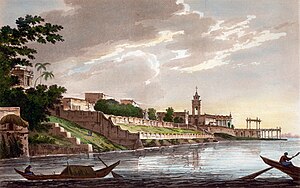User:Tinkaer1991/Attack in Hooghly
| Attack in Hughli | |||||||
|---|---|---|---|---|---|---|---|
| Part of Dano-Mughal War | |||||||
 A View of Chinsura, the Dutch settlement in Bengal | |||||||
| |||||||
| Belligerents | |||||||
|
| |||||||
| Commanders and leaders | |||||||
|
|
| ||||||
| Strength | |||||||
|
6500 men Multiple ships | 2 ships | ||||||
| Casualties and losses | |||||||
| 1500 dead[a] | 2 ships destroyed | ||||||
The Attack in Hooghly (Danish; Angrebet i Hooghly) was a Danish attack on two Bengali ships during the Dano-Mughal War in 1671. The Danes succeded in blowing up the Bengali ships, and violence continued off the coasts of Kalingapatnam and Balasore.
Background
[edit]
In 1642 the Danish East India Company declared war on the Mughal Empire.[1][2] Because of the Dano-Swedish Wars Denmark did not have the means to send any ships to Danish India, and relations were subsequently cut.[3] Relations with Denmark were reestablished in 1669 together with a new Danish East India Company.[4] At this point the war against Bengal was approved by the Danish government, yet urged the Danes in India to sue for peace if advantageous.[4][5]
In 1672 king Christian V of Denmark (r 1670-1699) requested compensation for the losses of Danish vessels, though this request was never fulfilled by the Mughals.[4] This, along with other factors, made the Danes increasingly brazen, and the Danes even attacked Bengal itself in 1671.[4]
Expedition to Bengal
[edit]In 1672 a Danish force of 6500 men were brought to Hooghly.[6] 1500 of the men was lost due to the sinking of a barge on the Ganges River.[6] The Danish East India Company sold most of their goods to two local Bengali merchants; Rangsordas and Sonderdas.[6] They sold their goods to them as a compromise not to trade with others for the next couple of months.[6] At Hooghly the Danes noticed two Bengali ships, which were returning from a voyage to Ceylon.[6] The ships were driven towards land near Hooghly, and the Danes subsequently blew the Bengali vessels up.[6][4]
Aftermath
[edit]The renewed violence continued during the following years.[4] In 1673 the Danes took a large Bengali ship of 170 cargoes near Balasore, and transported it to Tranquebar. This also happened to another ship which was carrying Maldivian cowries the same year.[4][7]
See also
[edit]Notes
[edit]- ^ Lost due to the sinking of a barge on the Ganges River
References
[edit]- ^ Wellen 2015, p. 448.
- ^ Videnskab 2018.
- ^ Bredsdorff 2009, p. 129.
- ^ a b c d e f g Wellen 2015, p. 457.
- ^ Andersen 1669.
- ^ a b c d e f Coolhaas 2007, p. 764.
- ^ Coolhaas 2007, p. 907.
Book sources
[edit]- Wellen, Kathryn (2015). The Danish East India Company's War against the Mughal Empire, 1642-1698 (PDF). Royal Netherlands Institute for Southeast Asian and Caribbean Studies.
- Coolhaas, Ed (2007). Generale missiven van gouverneurs-generaal en raden aan heren XVII (in Dutch). Vol. III. pp. 763–764.
- Bredsdorff, Asta (2009). The Trials and Travels of Willem Leyel. Copenhagen: Museum Tusculanum Press. ISBN 9788763530231.
- Andersen, Eskil (1669). Ostindiske sager (1668 - 1699). Copenhagen: Danske Kancelli.
Websites
[edit]- Videnskab (2018). Serampore var en glemt dansk koloni – mens den var koloni (in Danish). Videnskab.dk.
